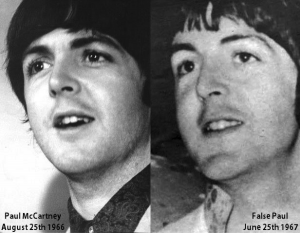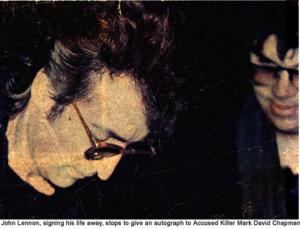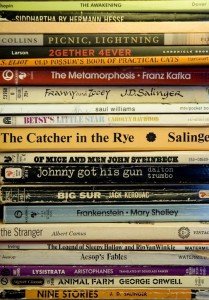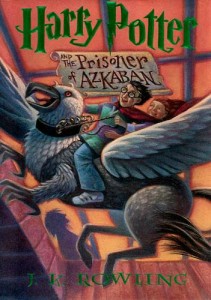Paul McCartney died in 1966 and was replaced by a look-alike imposter. He never played the half-time show at the Super Bowl. He was never knighted by Queen Elizabeth. And, he never married or fathered his four children. Actually, the remaining Beatles members covered up his death to keep their band together and on the rise, or so crazed conspiracy theorists believe. These theorists point out that the remaining Beatles started hiding hints in their music that the real Paul was dead. They believe every song on the Sgt. Pepper’s Lonely Hearts Club Band album is full of clues suggesting Paul’s death. In this album, The Beatles had assembled a new band with an imaginary member named Billy Shears. Believers of the conspiracy think that this fictional member was named for Paul’s  replacement. In the song “A Day in the Life,” the lyrics say: “he blew his mind out in a car.” When you play the song “I’m So Tired” backwards, you hear the lines “Paul is dead, miss him, miss him.” At the end of “Strawberry Fields Forever,” John Lennon sings, “I buried Paul,” though he later claims to have said “cranberry sauce” and “I’m very bored.” Believers in the Paul-is-dead conspiracy also find their proof in the backwards loops of songs and on album covers, which show things like raw meat and doll limbs (1966’s Yesterday and Today). Finally, on the cover of the Sgt. Pepper’s Lonely Hearts Club Band, there is a yellow wreath of flowers in the shape of a bass guitar, which believers think stands for a memorial to the real Paul McCartney.
replacement. In the song “A Day in the Life,” the lyrics say: “he blew his mind out in a car.” When you play the song “I’m So Tired” backwards, you hear the lines “Paul is dead, miss him, miss him.” At the end of “Strawberry Fields Forever,” John Lennon sings, “I buried Paul,” though he later claims to have said “cranberry sauce” and “I’m very bored.” Believers in the Paul-is-dead conspiracy also find their proof in the backwards loops of songs and on album covers, which show things like raw meat and doll limbs (1966’s Yesterday and Today). Finally, on the cover of the Sgt. Pepper’s Lonely Hearts Club Band, there is a yellow wreath of flowers in the shape of a bass guitar, which believers think stands for a memorial to the real Paul McCartney.
This famous conspiracy was developed in the 1960s but resurfaced after several websites claimed that Ringo Starr admitted to hiding Paul’s death in a recent, secret interview, according to United Kingdom’s The Mirror. Other prestigious publications, Time magazine being one of them, have published articles on this famed conspiracy. When I hear about things like this, I wonder how people find time to comb over everything Beatles in search for proof that today’s Paul McCartney is actually one lucky phony named Billy Shears. Apparently, because the Paul McCartney on the cover of the Beatles’ album Abbey Road is barefoot, means that he had died three years earlier.
Think these Paul-is-dead believers are off their rockers? Beatlemania sparked some even crazier conspiracy theories over the years: All of the Beatles died and were secretly replaced—except for Paul McCartney, several different imposters have acted as the real Beatles over the years, and my personal favorite, the illuminati formed the band in attempt to hypnotize youth listeners with subliminal messages advocating drug use which would alter their personalities. Others believe that the band members murdered their original drummer, Pete Best, and that the band has several songs that they’ve kept hidden in the event that they ever need more money,
Reading up on the madness that surrounds Beatle conspiracy theories, I began to wonder, are there any equally wild conspiracy theories about what we consider “classic” literature? So naturally I typed “literary conspiracy theories” into a Google search and not shockingly came across about 683 thousand results about classic literary characters, plotlines, settings, authors, and just about anything else you could think of.
 According to Norwegian filmmaker Nine Grunfeld, J.K. Rowling, author of the beloved Harry Potter series, does not exist. Grunfeld believes that no average working mom could become this idolized author, who published seven novels in ten years and sold over 250 million copies internationally. According to Grunfeld, there is no possible way that a nobody of an author could accomplish what “J. K. Rowling” has accomplished. Instead, the face we all know as the author of Harry Potter is just an actress who is the face for an entire team of writers.
According to Norwegian filmmaker Nine Grunfeld, J.K. Rowling, author of the beloved Harry Potter series, does not exist. Grunfeld believes that no average working mom could become this idolized author, who published seven novels in ten years and sold over 250 million copies internationally. According to Grunfeld, there is no possible way that a nobody of an author could accomplish what “J. K. Rowling” has accomplished. Instead, the face we all know as the author of Harry Potter is just an actress who is the face for an entire team of writers.
Some theorists believe that J.R.R. Tolkien and C.S. Lewis, two of the most famous fantasy authors of all time, were both members of the Occult and were using their fantasy novels to prepare the world for the New World that was coming. Tolkien’s Lord of the Rings series is claimed to have been an adapted version of a Wiccan text called The Book of Shadows. And Lewis, whose famous lion character Aslan is often called a Jesus-figure, is actually alluding to pagan deities. Theorists argue that in order to practice witchcraft, one must read all of C.S. Lewis’ works.
It’s only fitting that nobody knows how Edgar Allan Poe died. He arrived in Baltimore on October 3, 1849 wearing someone else’s clothes and acting delirious and strange. He mysteriously died four days later. One of the most widely-believed theories surrounding Poe’s death claims that Poe was kidnapped during election season. The kidnappers beat him and got him drunk, then took him to the polls and forced him to vote for their preferred candidate multiple times. The kidnappers then swapped around all of their hostages’ clothes so that none of them would be recognized and jailed for rigging the elections.
 Finally, and most interestingly, some people actually believe that author Stephen King murdered John Lennon. In a book called Stephen King Shot John Lennon, author Steve Lightfoot argues that Richard Nixon and Ronald Reagan hired King as their henchman to kill John Lennon and end his peace protests once and for all. According to the conspiracy theorists, Mark David Chapman, the man who was blamed for killing John Lennon, was just an actor who was paid to take responsibility for the murder. There is a famous picture of John Lennon giving his alleged murderer, Chapman, his autograph mere hours prior to his murder, which is one of Lightfoot’s biggest supporting arguments. Lightfoot says that he has received multiple threatening letters from King to keep him from spreading information about the murder.
Finally, and most interestingly, some people actually believe that author Stephen King murdered John Lennon. In a book called Stephen King Shot John Lennon, author Steve Lightfoot argues that Richard Nixon and Ronald Reagan hired King as their henchman to kill John Lennon and end his peace protests once and for all. According to the conspiracy theorists, Mark David Chapman, the man who was blamed for killing John Lennon, was just an actor who was paid to take responsibility for the murder. There is a famous picture of John Lennon giving his alleged murderer, Chapman, his autograph mere hours prior to his murder, which is one of Lightfoot’s biggest supporting arguments. Lightfoot says that he has received multiple threatening letters from King to keep him from spreading information about the murder.
Conspiracy theories are mind-boggling and make me wonder how people come up with these crazy ideas. In the end, however, I guess you could ask the same question of fiction writers because, as I found in my research, reading about these conspiracies is like reading a flash-detective story, where all of the clues are laid out to justify the outcome of the mystery.
–Emily Flippo




